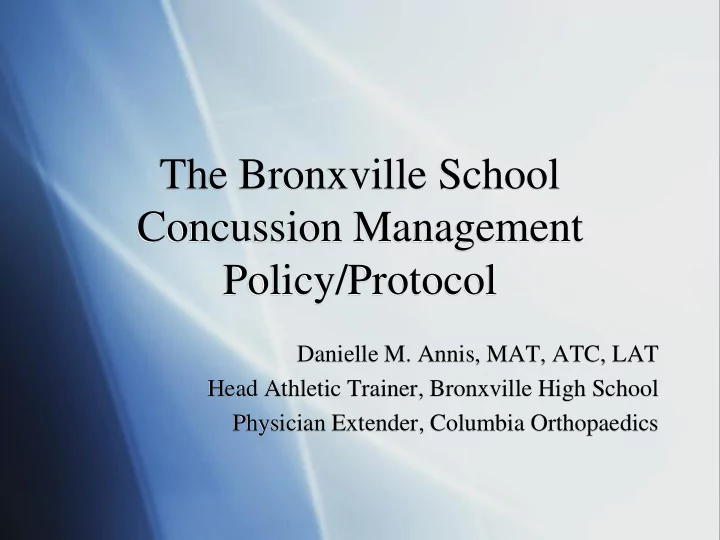

The Bronxville School Concussion Management Policy/Protocol Danielle M. Annis, MAT, ATC, LAT Head Athletic Trainer, Bronxville High School Physician Extender, Columbia Orthopaedics
On-Location Management of Concussions Loss of Consciousness No Loss of Consciousness Removed from activity and Duration of LOC doesn ’ t evaluated by appropriate matter, still treated as staff member with MEDICAL EMERGENCY concussion checklist Transported to ER by EMS If student has any Student must sit out 7 days symptoms, they may not and be symptom free before return to activity that day beginning return-to-play Doctor referral for protocol concussion **In both cases, parents and Concussion Management Team will be notified**
Concussion Checklist
Off-Location Management (Out of School Concussions) Parent/Guardian MUST notify the Nurse ’ s office Nurses will notify the Concussion Management Team Student must be seen by the school doctor
Physician Clearance Students suspected with a concussion should be evaluated by a private licensed MD (preferably neurologist) for diagnosis and appropriate medical care Once student is asymptomatic for 24 hours, should be re-evaluated to return to activities (PE and sports). Must have written clearance! Once written clearance is obtained from PMD, student must be cleared by the school physician to begin return-to-play
Return-to-Play Protocol 6 Phases 24 hours is recommended between each phase MUST HAVE WRITTEN CLEARANCE FROM PMD AND SCHOOL PHYSICIAN PRIOR TO BEGINNING RTP
Phase 1-Rest and Recovery Physical and cognitive rest until SYMPTOM-FREE Physical rest-adequate sleep, wake up without alarm Cognitive rest-avoid TV, video games, computer, texting, reading, bright lights, loud noises, studying/homework
Phase 2-Light Aerobic Exercise Light activity such as walking on treadmill or riding stationary bike for 15 min Objective is to increase heart rate and maintain asymptomatic state
Phase 3-Moderate Aerobic Exercise/Sport Specific Drills Jogging for 20 minutes Skills necessary for sport (ex. shooting drills for basketball) Objective is to further increase heart rate and add movement while remaining asymptomatic
Phase 4-Non-Contact Practice Student may participate in all aspects of practice that don ’ t require contact Examples-passing and shooting drills in lacrosse as opposed to scrimmaging Objective is for exercise, coordination, and add a cognitive aspect to return-to-play
Phase 5-Full Contact Practice Allowed to participate in full practice with no restrictions and intense aerobic activity Objective is to increase confidence, assess functional skills while remaining asymptomatic
Phase 6-Return-to-Play Student must be seen again by school physician after successfully completing phases 1-5 and remaining asymptomatic Once cleared, may return to all practices and games with no restrictions
Return-to Play Protocol If any symptoms should return during RTP, student must rest until symptom-free for 24 hours, then begin RTP from previous phase.
Recommend
More recommend